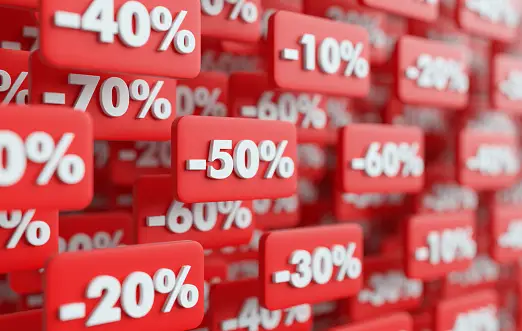Promotional pricing is a common strategy used by retailers to attract customers, boost sales, and clear inventory. For consumers, understanding promotional pricing is crucial for making informed purchasing decisions and avoiding potential pitfalls. This blog post explores what promotional pricing is, how it works, and how customers can navigate it effectively.
Table of Contents
1. What is Promotional Pricing?
Promotional pricing involves temporarily reducing the price of a product or service to stimulate demand and attract customers. This strategy is used by retailers and businesses to:
- Increase Sales Volume: By offering discounts, retailers aim to drive higher sales and increase foot traffic or website visits.
- Clear Out Inventory: Promotions help move excess stock or seasonal items that are nearing the end of their shelf life.
- Attract New Customers: Special offers can draw in new customers who might be hesitant to make a purchase at full price.
- Reward Loyal Customers: Promotions can be used to thank existing customers and encourage repeat business.
2. Common Types of Promotional Pricing
Understanding the different types of promotional pricing can help consumers recognize and evaluate offers more effectively:
a. Discounted Prices
Retailers often reduce the regular price of products for a limited time. Discounts can be:
- Percentage-Based: For example, “20% off” the regular price.
- Fixed Amount: For example, “$10 off” the regular price.
Example: A store might offer 30% off on all clothing items for a weekend sale.
b. Buy One, Get One (BOGO)
This promotion involves offering a free or discounted item with the purchase of another item. Common variations include:
- Buy One, Get One Free: Purchase one item and receive another of equal or lesser value for free.
- Buy One, Get One at a Discount: Purchase one item and get a second at a reduced price.
Example: Buy one pair of shoes and get the second pair at 50% off.
c. Limited-Time Offers
These promotions are available for a specific period, creating urgency for customers to make a purchase. Examples include:
- Flash Sales: Short-term sales lasting a few hours or days.
- Daily Deals: Special offers available only for one day.
Example: An online retailer might have a flash sale offering 40% off select electronics for 24 hours.
d. Seasonal Promotions
Retailers often run promotions tied to seasons or holidays to capitalize on increased shopping activity. Common seasonal promotions include:
- Holiday Sales: Discounts around major holidays like Christmas, Diwali, or Black Friday.
- End-of-Season Sales: Discounts on seasonal items as new inventory arrives.
Example: Winter coats might be discounted at the end of winter to make way for spring apparel.
e. Loyalty Rewards
Retailers offer special promotions to reward loyal customers. These can include:
- Points-Based Discounts: Earn points with each purchase that can be redeemed for discounts or free items.
- Exclusive Member Offers: Special promotions available only to members of a loyalty program.
Example: A coffee shop might offer a free drink after every ten purchases.
3. How to Evaluate Promotional Pricing
To make the most of promotional pricing, consumers should evaluate offers carefully:
a. Compare Prices
Before making a purchase, compare the promotional price with the regular price and prices from other retailers. This helps determine if the offer is genuinely a good deal.
Example: Check if the “50% off” deal is actually lower than the regular price or if the product is available at a better price elsewhere.
b. Check the Fine Print
Promotional offers often come with conditions and exclusions. Always read the fine print to understand:
- Validity Period: Ensure the promotion is still active and not expired.
- Exclusions: Some items or brands may be excluded from the promotion.
- Purchase Requirements: Check if there are minimum purchase requirements or other conditions.
Example: A discount might apply only to items from a specific collection or exclude already discounted products.
c. Assess the Value
Evaluate if the promotional price provides real value. Consider factors such as:
- Product Quality: Ensure that the discounted product meets your quality standards.
- Long-Term Savings: Consider if the promotion offers genuine savings or if it encourages unnecessary purchases.
Example: A “buy one, get one free” deal might be attractive, but only if you actually need both items.
4. Common Pitfalls to Avoid
Be aware of potential pitfalls associated with promotional pricing:
a. Overpaying for Unnecessary Items
Promotional pricing can sometimes lead to impulse buying. Avoid purchasing items you don’t need just because they’re on sale.
b. Misleading Discounts
Sometimes, retailers increase the original price before applying a discount to make the offer seem more attractive. Verify the authenticity of the original price before purchasing.
c. Limited Availability
Promotions might be limited in stock or availability. Act quickly if you’re interested, but also ensure that the product is still available in the desired quantity or size.
5. Strategies for Savvy Shopping
To maximize the benefits of promotional pricing:
a. Sign Up for Alerts
Subscribe to newsletters, follow brands on social media, or use price alert apps to stay informed about upcoming promotions and deals.
b. Plan Ahead
Monitor sales calendars and plan purchases around major sales events or seasonal promotions to take advantage of discounts.
c. Use Coupons and Codes
Combine promotional pricing with coupons or discount codes for additional savings.
6. Conclusion
Understanding promotional pricing is essential for making smart purchasing decisions. By recognizing different types of promotions, evaluating offers carefully, and avoiding common pitfalls, consumers can take full advantage of discounts while ensuring they get real value. Stay informed, compare prices, and plan your purchases strategically to make the most of promotional pricing in your shopping experience.
Disclaimer: The information provided in this blog post is for general informational purposes only. While promotional pricing can offer significant savings, the effectiveness and value of such promotions may vary based on individual circumstances and retailer practices. We make no warranties or representations about the accuracy or suitability of the information provided. Always verify promotional details and read terms and conditions before making a purchase.






